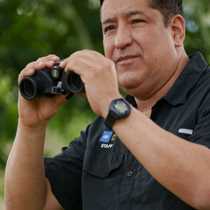El Dorado & Atun Poza
We awoke again to a cloudy morning, which is a blessing here in the Amazon. We explored “El Dorado” a relatively small tributary of the Uyacali River. At this location we devoted our time to looking for wildlife. We found a raucous flock of hoatzins (Ophistocomus hoazin). This bird species is by far one of the most interesting ones of the Amazon — Hoatzins when young have claws. For me the real highlight was the chance to remain in silence for a long time enjoying the intrinsic beauty of the solitude that this remote location evokes.
As little by little the sun started to shine we made our way back to the ship. We returned for breakfast which was followed by another Natural History talk by me on “The Ecology and Morphology of the Primates of the Upper Amazon.” A couple of crewmembers followed this talk with an amazing demonstration of how they use origami methods to fold our towels that they place on our cabins every night. This demonstration provided lots of fun for several guests participating as volunteers in the towel origami-folding.
In the early afternoon a persistent rain accompanied us during our navigation. At the disembarkation time the rain intensified from a drizzle to a heavy rain. With patience we waited and the rain finally stopped, but it was already too late forcing us to call off the visit. Our guests used this spare time to rest, take notes, enjoy a drink, draw maps, get acquainted with our wildlife checklist, bond and ultimately enjoy the comfort of their superb cabins. Some guests mentioned to me that they loved the feeling of getting drowsy while contemplating the rain from the coziness of their cabins.
After an exquisite dinner we went out on our skiff fleet with the intention of spotting wildlife at night. We used a big spotlight operated by our naturalists to see nocturnal wildlife. There were types of night jars or night hawks called pauraques that eat insects, and a relative of these called the Great Potoo, a much larger owl-size insect eater. Many fishing bats were flying up and down the creek, echo locating for fish off the ripples fish make as they come to the surface to catch insects.
We also found small spectacled caimans in the floating vegetation. These are the most common caiman in South America and a member of the Alligator family. Several skiffs also found a variety of frogs and everyone came home thrilled at having experienced the transition from day to night and watching the nocturnal environment unfold. With the aid of a spotlight we found a juvenile Spectacle caiman (Caiman crocodillus ssp). Please see in the picture the characteristic spectacle bridge crossing the snout that gives the common name to this reptile. Once onboard with our adrenaline still to the top we had the chance to interchange our impressions of this phenomenal day.



